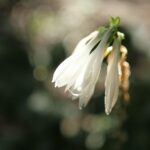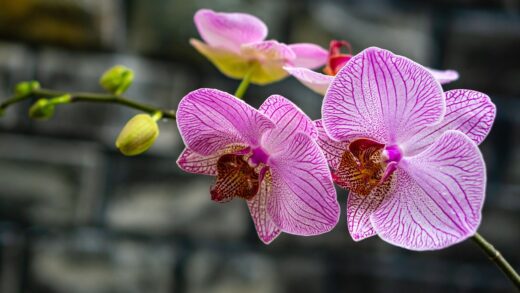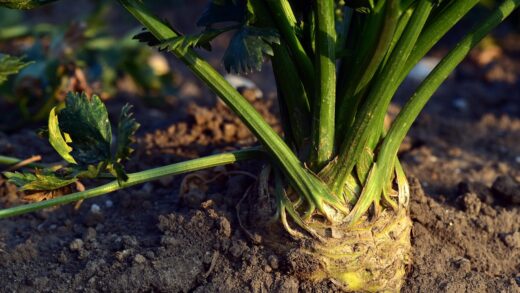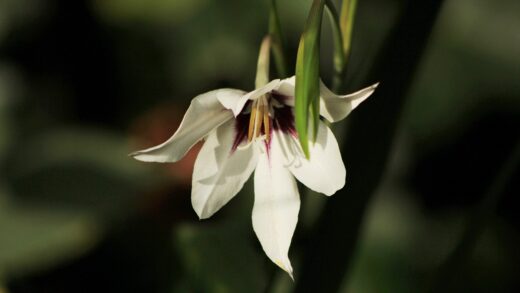While Geum coccineum is generally regarded as a robust and relatively trouble-free perennial, it is not entirely immune to the challenges posed by various diseases and pests. Proactive management and a keen observational eye are the best defenses, allowing a gardener to identify and address potential issues before they escalate into serious problems. Understanding the common culprits that can affect scarlet avens, as well as the environmental conditions that favour them, is the first step toward implementing effective, integrated pest and disease management strategies. A healthy, well-cared-for plant growing in its preferred conditions is always the most resilient against these threats.
The most common diseases to affect scarlet avens are fungal in nature, with powdery mildew and downy mildew being the most likely offenders. Powdery mildew appears as a distinctive white, dusty coating on the surface of the leaves, stems, and sometimes the flowers. Downy mildew, on the other hand, typically presents as yellowish patches on the upper surface of the leaves, with a corresponding fuzzy or mouldy growth, often purplish-grey in colour, on the undersides. Both of these diseases thrive in conditions of high humidity and poor air circulation.
Root and crown rot are more serious, often fatal, issues that are almost always linked to poor growing conditions. These diseases are caused by water-mould pathogens that flourish in soil that is consistently waterlogged and poorly drained. The symptoms above ground can be deceptive, often appearing as wilting, yellowing leaves, and a general decline in plant health, which could be mistaken for underwatering. However, an inspection of the plant’s base will reveal a soft, mushy, and often discoloured crown and rotting roots, a clear sign of this devastating problem.
On the pest front, scarlet avens is not a primary target for many insects, but it can occasionally be troubled by common garden pests. Aphids are small, sap-sucking insects that may congregate on new growth and flower buds, causing distortion and weakening the plant. Slugs and snails can also be a nuisance, particularly in damp conditions, where they will chew ragged holes in the tender leaves. More significant, though less common, is damage from the larvae of the vine weevil, which feed on the roots underground, causing the plant to wilt and collapse suddenly.
Preventing fungal diseases
Prevention is by far the most effective strategy when it comes to managing fungal diseases in the garden. The cornerstone of prevention is to provide the right growing conditions, with a particular focus on ensuring excellent air circulation. This starts with proper spacing at planting time, giving each scarlet avens plant enough room to grow to its mature size without being crowded by its neighbours. This space allows air to flow freely around the foliage, which helps it to dry quickly after rain or watering, making it a much less hospitable environment for fungal spores to germinate.
Watering technique also plays a critical role in disease prevention. As fungal pathogens thrive in damp conditions, it is crucial to keep the foliage as dry as possible. Always water your plants at the base, directly onto the soil, using a soaker hose or a watering can. Avoid using overhead sprinklers, which wet the leaves and create the ideal conditions for mildew to take hold. Furthermore, watering in the early morning gives the sun a chance to dry any accidental splashes on the leaves during the day, reducing the risk of overnight infection.
Good garden sanitation is another key preventative measure. Fungal spores can overwinter on dead plant material, so it is important to clean up fallen leaves and debris from around the base of your plants throughout the season. In the autumn, after the first hard frost, cut back the old foliage and stems of your Geum coccineum and dispose of them, especially if you have had any disease issues during the year. This removes a primary source of inoculum for the following spring.
For gardens where powdery or downy mildew is a persistent problem, preventative applications of a fungicide can be considered. There are many organic options available, such as sprays based on potassium bicarbonate, neem oil, or sulfur. These work by creating a protective barrier on the leaf surface or by altering the pH to make it hostile to fungal growth. These preventative sprays should be applied early in the season, before any symptoms appear, and may need to be reapplied according to the product’s instructions, particularly after heavy rain.
Integrated pest management
Integrated Pest Management (IPM) is a holistic and environmentally sensitive approach to dealing with garden pests that prioritizes the least toxic methods first. The first line of defense in IPM is cultural control, which involves creating a healthy garden environment that is less attractive to pests. For scarlet avens, this includes maintaining healthy, vigorous plants through proper watering and feeding, as healthy plants are better able to withstand minor pest attacks. It also involves regular weeding to eliminate hiding spots for pests like slugs and aphids.
Biological control is another key component of IPM, which involves encouraging the presence of natural predators in your garden. Ladybugs, lacewings, and hoverflies are all voracious predators of aphids. You can attract these beneficial insects by planting a diverse range of flowering plants, particularly those with small flowers like alyssum, dill, and fennel. By creating a habitat that supports these natural enemies, you can establish a self-regulating system where pest populations are kept in check without the need for chemical intervention.
When pests are present, physical and mechanical controls should be the next step. A strong jet of water from a hose can be very effective at dislodging small colonies of aphids from your plants. For slugs and snails, hand-picking them off plants in the evening is a direct and effective method. Traps, such as beer traps sunk into the soil, can also be used to lure and drown these mollusks. Barriers like copper tape around pots or crushed eggshells around the base of plants can also deter them.
If pest populations become unmanageable through these other methods, chemical control may be considered as a last resort. Always choose the least toxic option first, such as insecticidal soaps or horticultural oils, which are effective against soft-bodied insects like aphids and have a low impact on beneficial insects and the environment. These work by direct contact, so thorough coverage of the pests is necessary. Reserve broad-spectrum synthetic pesticides for severe infestations where the survival of the plant is at stake, and always use them strictly according to the label directions.
Treating common ailments
If, despite your best preventative efforts, your scarlet avens does develop a fungal disease, prompt action can help to control its spread. For a minor infection of powdery mildew, the first step is to remove and destroy the most heavily affected leaves to reduce the number of fungal spores. Then, apply a fungicide to the rest of the plant, ensuring good coverage of both the upper and lower leaf surfaces. Organic options like neem oil or a potassium bicarbonate solution are often effective, but may need to be reapplied every 7-10 days until the conditions favouring the disease have passed.
Treating root and crown rot is significantly more challenging, and often, by the time it is diagnosed, it is too late for the entire plant. The best hope for salvation is to act immediately. Carefully dig up the affected plant and wash the soil from its roots. Using a sharp, sterile knife, cut away all the blackened, mushy, and rotting parts of the roots and crown, back to healthy, white tissue. If any healthy sections with viable roots and buds remain, they can be dusted with a fungicide powder and replanted in a new location with much-improved drainage or in a container with fresh, sterile potting mix.
For an infestation of aphids, a simple spray of soapy water can be surprisingly effective. Mix a few drops of washing-up liquid into a spray bottle filled with water and apply it directly to the aphid colonies. The soap breaks down the insects’ protective outer layer, causing them to dehydrate. For a more persistent problem, horticultural oil or neem oil sprays are also very effective and have a relatively low impact on beneficial insects when applied correctly, typically in the evening when pollinators are less active.
Managing vine weevil larvae requires a different approach, as they live in the soil and feed on the roots. The most effective and environmentally friendly control is the application of pathogenic nematodes, specifically Steinernema kraussei. These are microscopic organisms that are watered into the soil, where they actively seek out and parasitize the vine weevil grubs. This biological control is best applied in late summer or early autumn when the soil is warm and the grubs are at a vulnerable stage in their life cycle.
Creating a resilient garden ecosystem
Ultimately, the most sustainable way to manage pests and diseases is to cultivate a resilient and diverse garden ecosystem. A garden that is a monoculture, with large plantings of a single type of plant, is much more vulnerable to a rapid outbreak of disease or a pest infestation. By contrast, a garden with a wide variety of plants—including different species of perennials, annuals, shrubs, and trees—creates a more complex and stable environment. This diversity provides habitats and food sources for a wide range of beneficial insects, birds, and other wildlife that act as natural pest controllers.
Promoting soil health is the foundation of a resilient garden. As discussed previously, soil rich in organic matter and teeming with microbial life supports stronger, healthier plants. Healthy plants have better structural defenses, such as tougher cell walls, and are more capable of producing the chemical compounds that deter pests and fight off diseases. By focusing on feeding the soil with compost and other organic amendments, you are building plant health from the ground up.
Reducing stress on your plants is another key factor. A plant that is stressed by drought, poor nutrition, or being planted in the wrong location is significantly more susceptible to attack from pests and diseases. Ensure that your Geum coccineum is planted in a site that meets its needs for sunlight and drainage, and provide it with consistent water and appropriate nutrition. A happy plant is a healthy plant, and a healthy plant is far more capable of fending for itself.
Finally, adopt a mindset of tolerance and observation. A completely pest-free and disease-free garden is an unrealistic and often undesirable goal. A small number of pests is necessary to sustain the populations of their natural predators. Learn to tolerate minor cosmetic damage and intervene only when a pest or disease population is reaching a level that truly threatens the health of the plant. By observing your garden closely, you will learn to understand its natural rhythms and balances, becoming a more effective and intuitive gardener.

















